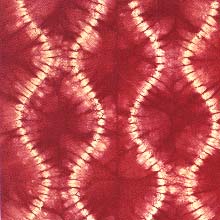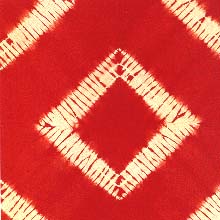Dye (p. 37 )
1. Produced in Hanawa, Kazuno City, Akita Prefecture.
2. Characteristics: "Akane"(Rubia akane) or "Shikon"(root of Murasaki, Lithospermum erythrorhizon ) is used as dye. The cloths are silk("Habutae" and "Tsumugi") and cotton, plain dyed or dapple dyed with 4 kinds of designs: "Omasu" "Komasu" "Tatewaku" and "Hanawa Shibori".
3. Uses: Garments, sashes, handkerchief (for tea ceremonies) and minor items.
4. History: "Akane" or "Murasaki" which grew wild, was used as dye since the Nara Period in this district. As the Feudal Clan of Nanbu gave them protection, the dyeing developed to an industry and the products were sent to Edo to be used as gifts to the Imperial Court and the Shogunate. After the Meiji Restoration(1868), the industry declined following the loss of feudal protection and also with the introduction of chemicals which became popular. And, in spite of coping with such difficulties as the lack of raw materials and long periods necessary for production, the Kuriyama Family still till today has been maintaining the "Akane" and "Shikon" dyeing.
Dyeing Method
The following is the method of dyeing a silk cloth.
1. Pre-dyeing: The cloths soaked in lye are dried in the sun on clear days from May to September. The work is repeated 130 times for the "Akane Zome" and 20 times for "Shikon Zome". After that the cloths are kept untouched for a year.
2. Tie-dyeing: Designs are given by dyeing manually or with wood plates.
3. Dyeing: Cloths are soaked in a dye liquid in a big tub. This task is repeated ten or more times until the desirable color is attained. The work is done on clear days as the cloths are dried in the sun.
4. Finishing: Ties are loosened and the cloths are kept in a cabinet for 2 to 4 years to fix the color.




